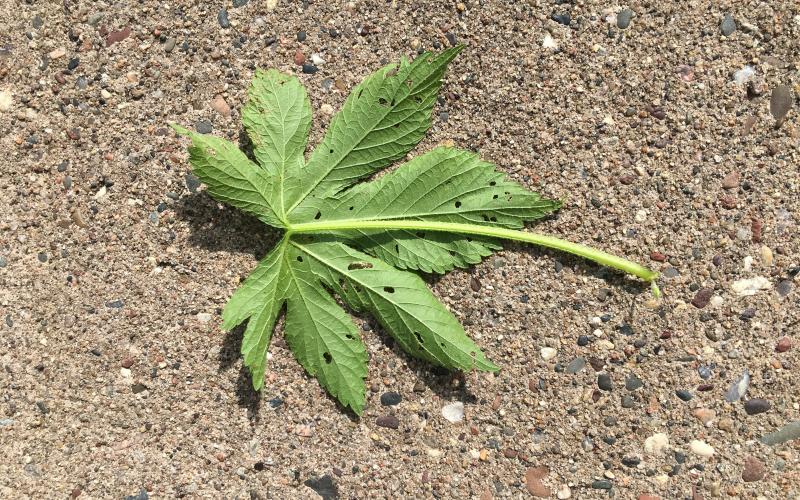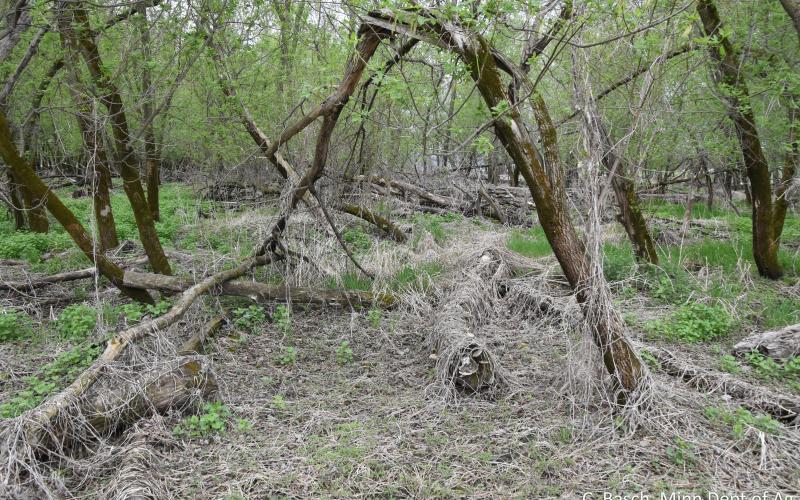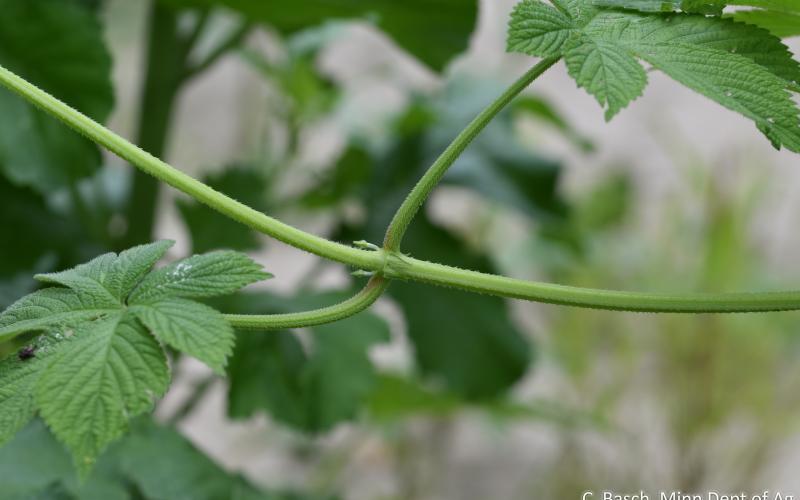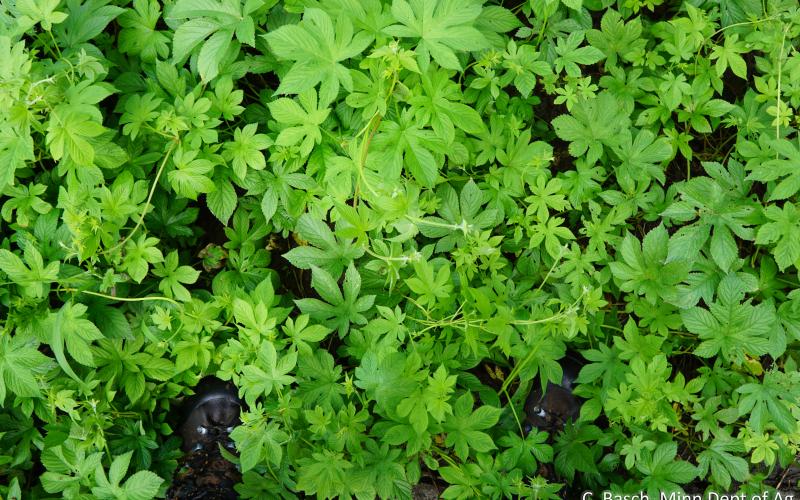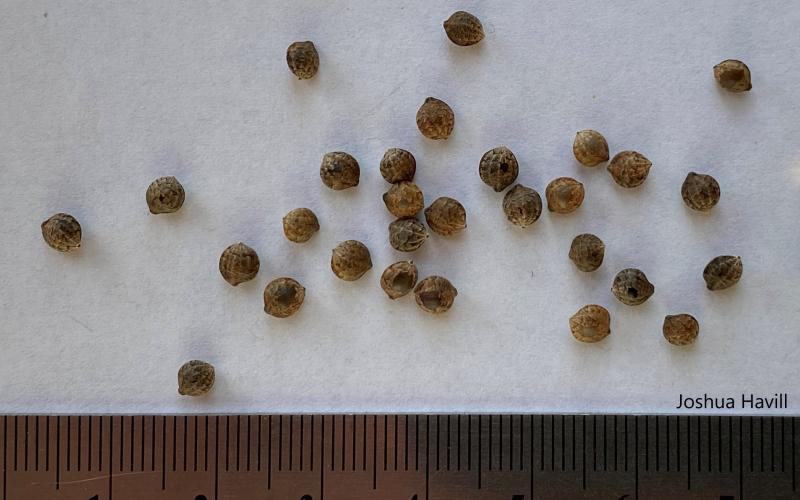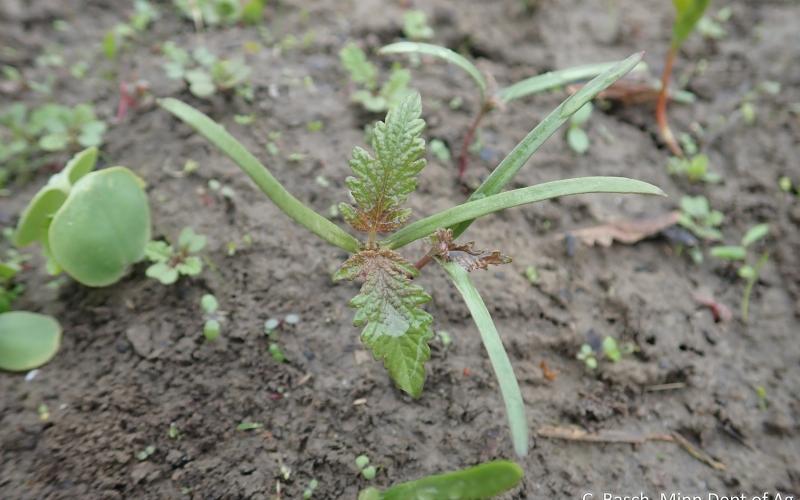Common Name: Hooked hair hops
Scientific Name: Humulus japonicus Sieb. & Zucc.
Alternate name: Japanese hops
Related Species: Common hops (H. lupulus) is a related species used for beer production.
Legal Status
All above and below ground parts of the plant must be destroyed. Additionally, no transportation, propagation, or sale of this plant is allowed. Failure to comply may result in an enforcement action by the county or local municipality.
Background
Hooked hair hops are native to eastern Asia and were introduced to North America as an ornamental in the mid-to-late 1880s. They have escaped cultivation and are displacing desirable species and impeding forest regeneration. Unlike common hops, which is a related species, hooked hair hops are not utilized for beer production. Fortunately, there are only a few infestations in Minnesota. The goal is to eradicate infestations before hooked hair hops vines spread and become a serious weed issue in Minnesota.
Description
- Hooked hair hops are herbaceous annual vines that can grow up to 35 feet in a single growing season. They twine to climb adjacent vegetation and structures and sprawl across open ground to form dense mats several feet deep.
- Leaves have toothed edges and 5-7 lobes arranged palmately. They are opposite and approximately 2-6 inches long. Stems and leaves have hooked hairs. There are distinct bracts where the leaf petioles attach to the stem.
- There are separate male and female plants. Both are greenish and produce flowers with five petals. Male flowers are arranged in airy cone-shaped clusters (panicles). Female flowers are arranged in short spikes. Hooked hair hops flowers in mid-late summer followed by seed production.
- Common hops (H. lupulus) is similar but has more rounded leaves with 0-5 lobes and is perennial. Sometimes bur cucumber (Sicyos angulatus) and wild cucumber (Echinocystis lobata) are mistaken for hooked hair hops, but can be distinguished because they do not have hooked, downward-pointing hairs on the leaves and stems and have tendrils on the stem.
Habitat
Hooked hair hops prefers full or partially sunny areas in riparian areas, grasslands, hayfields, and roadsides. It will invade disturbed habitats, but can also colonize undisturbed sites like forest edges and fields.
Means of spread and distribution
Hooked hair hops reproduce by seed that can be dispersed by wind, water, wildlife, vehicles and equipment.
Most hooked hair hops infestations occur in eastern states, although this species is spreading in the Midwest. In Minnesota, there are two confirmed occurrences in the southeast, one along the Root River and the other along the Mississippi River. The infestation on the Mississippi is just north of a series on infestations in adjacent Iowa and Wisconsin.
Impact
Hooked hair hops grows so rapidly that it can smother other plants. It can form dense patches that outcompete and displace native vegetation. It can spread to cover large areas of open ground or low vegetation including twining around understory trees and shrubs, sometimes causing them to break or fall over.
Prevention and management
- Do not plant hooked hair hops. Prevent seed from moving on clothing, vehicles, and equipment from infested areas. It is expected that the seedbank longevity for hooked hair hops is approximately three years. Therefore, most of the control effort will be required during the first two years after which monitoring and spot treating will be required for several years.
- Repeated hand-pulling is an option to control small infestations. It is easiest to pull early in the season before the root system becomes established and extensive. Flowering stems or stems with seed should be bagged or burned. Protective clothing should be worn when handling hooked hair hops because of its prickly hooked hairs.
- Repeated cutting with tools such as a weed-whip, brush-cutter, or mower is another option for controlling small infestations. Unfortunately, the vines re-grow quickly from cut stems so frequent cutting is necessary. The best time of year to mow is mid-May through July. Do not mow after seed set in the early fall because the mower will facilitate seed dispersal.
- Repeated foliar application of a systemic herbicide containing glyphosate can be an effective tool for controlling hooked hair hops. Apply in the early summer to prevent seed production. Depending on the site considerations, foliar application could be combined with a pre-emergent herbicide for more effective control. For specific herbicide recommendations, contact your local University of Minnesota Extension agent.
Toxicity
Many people have an allergic reaction to hooked hair hops pollen. In addition, the hooked hairs on the stems and leaves can cause dermatitis and blistering skin after contact.
